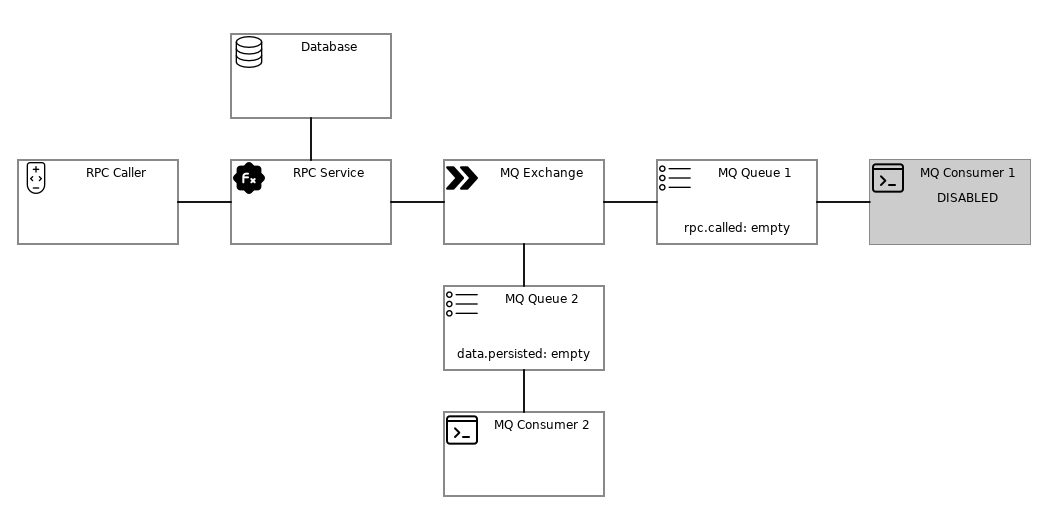FEEL FREE TO CONTRIBUTE TO THIS PROJECT
As a Software Architect I'm a big fan of sequence diagrams. I like the way they convey so much information in a orderly manner. But it can be quite a challenge for most normal people and even for a lot of Software Engineers to understand the information flux and what each component is supposed to do using such diagrams.
So I thought it would be nice to put on screen the architectural pattern more or less in the way it shows itself in my own head. I would like to be able to draw a component and be able to easily show basic things like:
- It is called by this other component;
- It should validate data;
- then save on database;
- then send a message to other components;
- and only then respond as a successful transaction.
- You must have Löve installed.
- Inside the repo root directory, run
love ..
- Arrow keys: for panning around.
x: to activate the first component (the one at (0,0)).spacebar: to advance one step (you can hold the key down to enable auto-advante).q: quit the program.- Left mouse button: to select a component.
- Right mouse button: to activate a component.
Please note that "activation" of a component by default means to disable it. It's a way to pretend that the component is down and to see what happens in your system.
RPC_Caller components calls RPCs when activated.
You can customize components and actions. Look at schema.lua for
examples.
I suggest you create a copy of schema.lua inside some schemata
directory and lay out your components as needed.
After that, just pass it as argument to the "run" script:
run.sh my-schema.lua
Since it's very important to understand the behavior of each component in a timely manner, the whole system is based on time beats or beats. You know, as if someone was beating a drum to mark the timing of each thing.
Common actions like responding to a call or processing a
response from some neighbour always has a step by which
you can guide yourself.
For instance: to process a call response, your component would:
- Change it's status to "Received "..response_data.response
- Maybe do something else with the response
- Clear it's status
(The status is shown on screen when set.)
You can trigger the first component action by pressing
x, or any other component by clicking with the right
mouse button (button 3).
(But remember: components are not forced to implement any action. The default action is to disable the component.)
Each component has an input_type and an output_type. They are used to
find which neighbour provides which method when a call happen.
While drawing components by hand I realized most of the time I was using a imaginary grid to lay out each box, so salms uses the same approach. I would hate to have to draw connections, so you can follow a simple rule: every neighbour is connected. If you don't want two components to be connected, simply put them apart of each other.
I was thinking about some way to define components almost like you would in PlantUML, where there is a "source code" that generates a PNG file with the diagrams.
This language would need a lot of flow control capabilities, so, in the end, I opted for using a programming language simple enough, fast enough and very portable: Lua.
You see, trying to define everything only with descriptions would lead to a descriptive language with weird flow control structures. So I found it way better to use a full-fledged programming language and make everything easy enough so that most of the time you can be very, very descriptive, while retaining the power to create more complex things if you need to.
GRPC_Service = {
input_type = "gRPC"
}
function GRPC_Service:call_action(call_args)
self.status = "Persisting..."
self:call_neighbours("db", "persist", call_args)
call_args.waiting = true
end
function GRPC_Service:response_step_one(response_data)
if response_data.responder.input_type == "db" then
-- Saved on database, now send message to other components:
self.status = "Sending message..."
self:call_neighbours("amqp.publish", "topic", {
original_context = response_data.context
})
elseif response_data.responder.input_type == "amqp.publish" then
self.status = "Response: "..response_data.response
response_data.context.original_context.waiting = false
end
endI chose a kind of object-oriented style, so all components
should be instantiated using components.add(x, y, class).
"class", in this case, would be GRPC_Service.
You'll find more components inside the components directory.
- Using it.
- Reporting bugs.
- Writing about it.
- Writing new components
- Helping to improve the code, specially to make it
easier to use for other Architects. (Check
TODO.mdfile.)
- Icons made by Pixel perfect from www.flaticon.com
